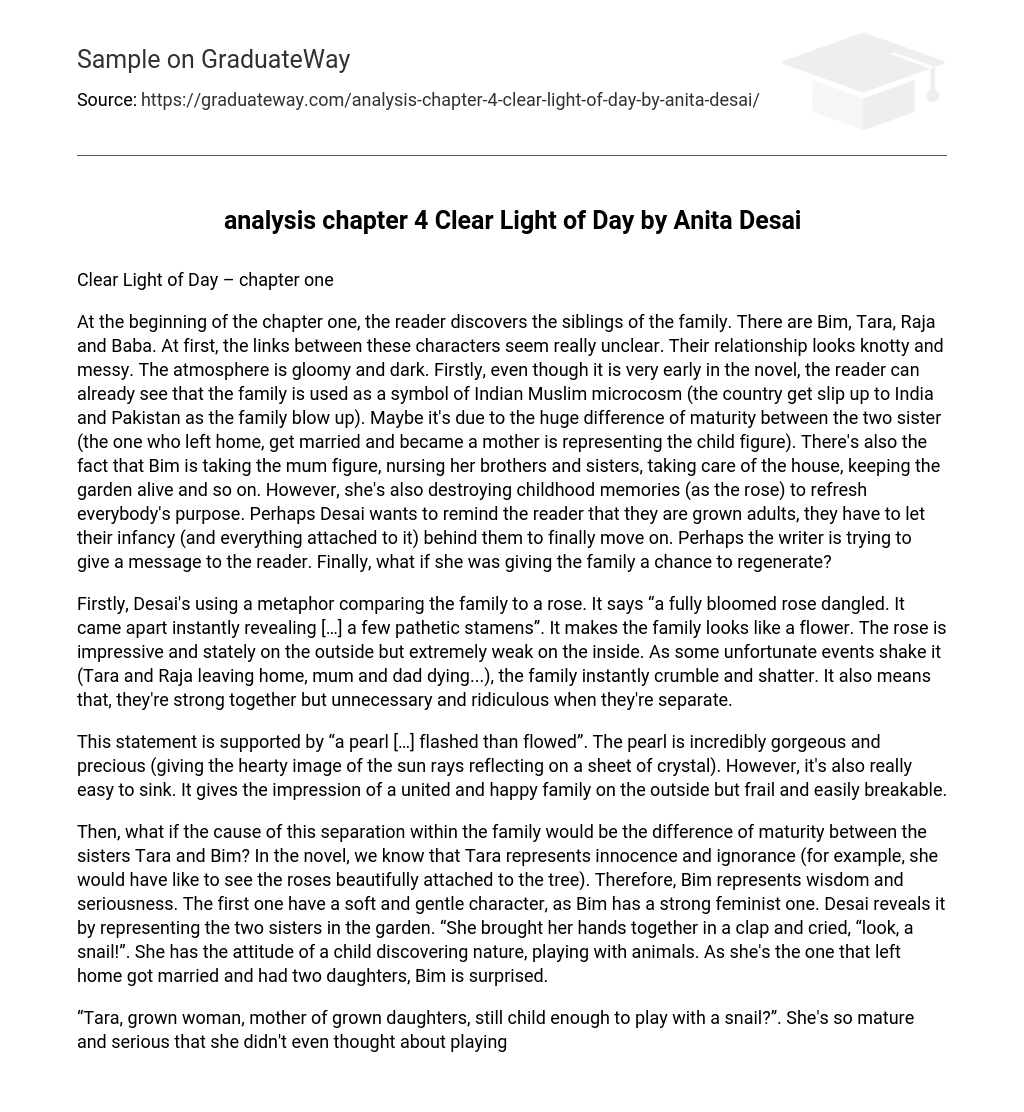At the start of chapter one, the reader is introduced to the family’s siblings: Bim, Tara, Raja, and Baba. Initially, the connections between these characters are unclear. Their relationship appears complicated and messy. The atmosphere is somber and dim. Even though it is early in the book, the family serves as a symbol of the Indian Muslim microcosm, with the country’s partition into India and Pakistan mirroring the family’s fragmentation. The significant difference in maturity between the sisters contributes to this dynamic, with the one who left home, got married, and became a mother embodying a childlike figure. Additionally, Bim takes on a motherly role, caring for her brothers and sisters, managing household tasks, and sustaining the garden. However, she also eradicates childhood memories like a rose to rejuvenate everyone’s purpose. This may suggest to readers that as grown adults, they must leave their infancy and associated attachments behind in order to progress. It is possible that Desai intends to convey a message to readers and offer the family an opportunity for regeneration.
Desai uses a metaphor to describe the family as a rose, saying that they are like a fully bloomed rose that appears impressive on the outside but weak on the inside. The metaphor suggests that the family is strong when together but vulnerable when separated, and this is highlighted by the rapid crumbling and shattering of the family when faced with unfortunate events such as Tara and Raja leaving home or their parents’ deaths.
Additionally, Desai uses another metaphor of a pearl to convey the image of a united and happy family that is also fragile and easily breakable. The pearl is described as incredibly gorgeous and precious, similar to the reflection of sunlight on a sheet of crystal. However, it is also portrayed as something that can easily sink.
Overall, both metaphors emphasize the delicate nature of the family and how appearances can be deceiving. The rose and pearl imagery symbolize the family’s vulnerability and their tendency to appear strong on the surface, but with underlying weaknesses.
What if the reason behind the family’s separation is the difference in maturity between Tara and Bim? In the novel, it is made clear that Tara represents innocence and ignorance. For instance, she wishes to see the roses attached beautifully to the tree. On the other hand, Bim symbolizes wisdom and seriousness, and also carries a strong feminist character. Desai illustrates this by depicting the two sisters in the garden. “She clapped her hands together and exclaimed, ‘Look, a snail!'” Tara behaves like a child, discovering nature and playing with animals. Bim, who left home, got married, and had two daughters, is surprised by this behavior.
Is Tara, a grown woman and mother of grown daughters, still childlike enough to play with a snail? She is usually seen as mature and serious, never having considered playing with a snail. Her sister’s immaturity surprises her, and it seems that the two sisters are reconnecting during this gathering. The author uses the word “eagerness” to describe Tara, perhaps to create a childlike atmosphere similar to an impatient child at a carnival, tugging on their mother’s skirt until they finally get the carousel ride they’ve been wanting for hours. This creates a sense of a childhood memory, with cotton candy sellers and soft music in the background, which contradicts Tara’s age.
By introducing the extreme maturity of Desai, she possibly wants to implicitly portray a new aspect of Bim. In addition, the use of the “rose” in the passage suggests that Bim is eradicating childhood. The theme of literal death is also explored, as the rose symbolizes childhood memories and its explosion signifies the loss of innocence and past experiences. Thus, when Bim allows the rose to fall before Tara’s eyes, it may be her way of urging Tara to grow and move on. However, the inclusion of the word “firefly” in the poem she reads to Baba holds symbolic significance. This conveys to the readers that there is potential for a renewal in their sister’s friendship.
Eventually, Bim assumes the role of the mother in the story. This becomes evident when she inquires, “did you sleep at all?” as she departs from the family residence. As a result, she now becomes the one who greets other family members, resembling a concerned mother fretting over her children’s well-being. Bim nurtures them, attempting to transform the old house, which is rife with unpleasant memories, into a warm and comforting space.
In the passage, it is revealed that she has an overprotective mother side as she “sat beside her brother’s bed that summer he was ill”. Throughout the entire summer, day and night, she cared for her sick brother. While other teenagers would go out to have fun, she stayed by his bedside, taking care of him, reading his favorite book, and ensuring he slept. This portrays her as a responsible adult, despite being just a child. She received an education in old India, which was quite significant during that time. She became a history teacher, cared for her autistic brother, and made every effort to maintain family ties. This is where the reader understands her strong feminist spirit.
In conclusion, Desai delves beneath the surface of this Indian family, seeking to understand rather than simply glancing at the surface. By the end of chapter one, it becomes clear that the family’s dynamics are intricate, possibly due to the maturity gap between Tara and Bim. It is suggested that Bim assumes a motherly role, employing a forceful approach to bring about change while keeping a watchful eye on everyone. Although Raja’s character is not extensively discussed, the way the sisters discuss him and the author’s use of first-person pronouns creates a significant distance. Ultimately, the novel’s title remains mysterious, but the reader is offered a clue as to how events may unfold.





